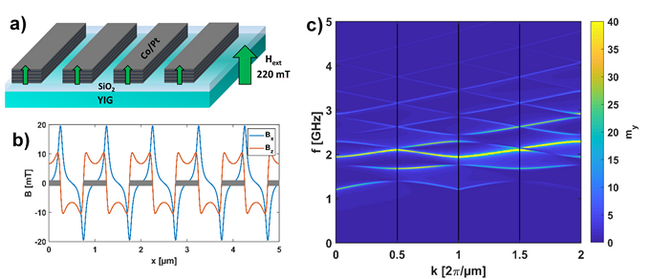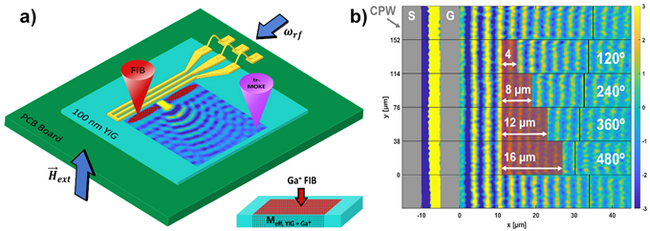Optically inspired computing devices based on spin waves
Spin waves (or quantized: magnons) are propagating collective excitations of magnetic spins. They provide an interesting and promising alternative for on-chip signal processing and computing. Fundamental circuit elements (magnonic transistor, logic gate, spin-wave bus) as well as more exotic devices (magnonic crystal, neuromorphic computing device, on-chip spectrum analyzer) were proposed, and in some cases, experimentally demonstrated. Although the numbers look promising in some figures of merit, with the currently available technology it is very difficult to challenge CMOS at its own game i.e. Boolean logic. However, spin-waves could excel in alternative computing architectures, where digital implementations are costly, e.g. in wave-based computing approaches and in RF analog signal processing.
Influencing Spin Waves with Dipole Fields of Co/Pt Nanomagnets
Within the scope of the current research project “Spin-wave platform in hybrid PMA/YIG films”, we are developing and experimentally demonstrating a hybrid ferri-/ferromagnetic platform for spin-wave-based computing and signal processing. YIG (yttrium-iron garnet) is chosen to be the medium for spin-wave propagation for its extremely low magnetic damping. Ferromagnets with PMA (perpendicular magnetic anisotropy) would provide effective and reconfigurable means to influence the propagation of spin waves; essential to create practical devices. PMA ferromagnets, fabricated on top of the YIG film, create magnetic fields patterns, which change the local dispersion properties of the underlying YIG film. The magnets may also be coupled to each other via dipole fields, building up a reconfigurable pNML (perpendicular nanomagnetic logic) circuit. This technique can be used to realize reconfiguration with a low number of magneto-electrical transducers. In summary, the goal of this project is the design and the experimental demonstration of a hybrid spin-wave based platform for future integrated computing and signal-processing devices.

b) The dipole fields of the nanomagnets change the spin wave dispersion relation in YIG locally, thus the array creates a periodic alternation of the magnonic refractive index.
c) Hence, the configuration of the dipole field pro-file results in the formation of magnonic bandgaps analogously to a photonic crystal.
Funding and Duration
This project is funded by the research grant “Spin-wave platform in hybrid PMA/YIG films” of German Science Foundation DFG
Duration: since 2019
Additional Funding kindly acknowledged from BaCaTec
http://www.bacatec.de/de/gefoerderte_projekte.html
Cooperation Partners
Technische Universität München TUM
Chair of Nanoelectronics
Further Information
Principal Investigator: Markus Becherer
Doctoral Candidates: Martina Kiechle
Homepage + Links
https://gepris.dfg.de/gepris/projekt/429656450
Ion Beam Engineering of YIG for Spin Wave based Computing Devices
Changing the effective magnetization Meff and the Gilbert damping αG in YIG thin films can be achieved by means of Focused Ion Beam (FIB). We utilize this technology to locally modify the spin wave dispersion relation without the need of physically removing material (e.g. etching), whereby the degree of manipulation is strongly dependent on the applied ion dose. This way, we can engineer the spin wave wavelength, phase and/or amplitude in irradiated areas, which is very useful
to fabricate complex magnonic building blocks, especially optically inspired components that require a variation of the refractive index. Low Ga+ ion doses can be used to increase Meff with little to no change in magnetic damping, leading to a relative refractive index >1. Higher doses decrease Meff and result in a strong increase of magnetic damping up until the magnetization is ‘switched off’ eventually, resulting in binary magnetization patterns.

b) Low ion doses change the spin wave wavelength through a change in Meff while damping is not significantly increased, and phase shifts can be created by a length variation of the irradiated regions.
Funding and Duration
Cooperation Partners
Technical University of Munich TUM
Chair of Nanoelectronics
Further Information
Principal Investigator: Markus Becherer
Doctoral Candidates: Martina Kiechle
Collaboration Partners
Prof. Gyorgy Csaba, Pazmany Peter Catholic University
Dr. Adam Papp, Pazmany Peter Catholic University
Homepage + Links
https://www.uni-kl.de/trr173/events/lectures/
https://www.uni-kl.de/fileadmin/trr173/Lectures_2020/SPINX_20200120_Ankuendigung_Martina_Kiechle.pdf